
Punjab is a northern state of India, with a major influence of Sikhism. The famous crafts of punjab are deeply rooted in its rich cultural heritage, which is a vibrant blend of traditions, music, dance, cuisine, and festivals. Known for its lively Bhangra and Giddha dances, soulful folk music, and colorful attire, Punjab exudes joy and energy. The cuisine, featuring dishes like Makki di Roti and Sarson da Saag, along with lassi, is renowned for its rich flavors. The warm hospitality of Punjabis, their love for celebrations like Lohri and Baisakhi, and their deep-rooted connection to agriculture make Punjab’s culture both unique and inspiring.
1. Jutti Making:
A perfect mix of tradition and culture which is equally loved by the people of all ages, ‘Jutti’ is derived from an Urdu word for a shoe. This type of shoe has a closed upper and is slipped-on. It is most commonly associated with Punjab and mostly worn in North India. Punjabi juttis were originally made out of leather and their uniqueness comes from the embellishments and embroidery. It is symbolic to authentic and ethnic beauty passed on through generations and is an important part of the traditional Punjabi culture. Even in today’s modern world juttis are considered a crucial ethnic apparel and they have carved their own special place. As they can be worn every day, to any occasion and are still considered an important part of the traditional ceremonies like weddings.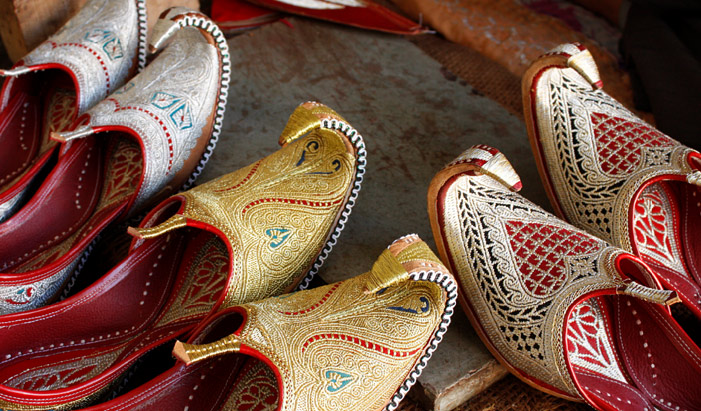
2. Metal Craft:
The Thatheras (Craftsmen Specializing in Metal Utensils) of Jandiala Guru specialize in traditional brass and copper utensil manufacturing in Punjab, using metals believed to promote health. The process involves flattening cooled metal cakes into plates, hammering them into various shapes, and requires careful temperature control with wood-fired stoves. Utensils are polished with sand and tamarind juice, and designs are created by hammering tiny dents into heated metal. They manufacture items for both ritual and practical uses, especially during weddings and religious occasions. The craft is passed down through generations, shaping their socio-economic status and kinship.
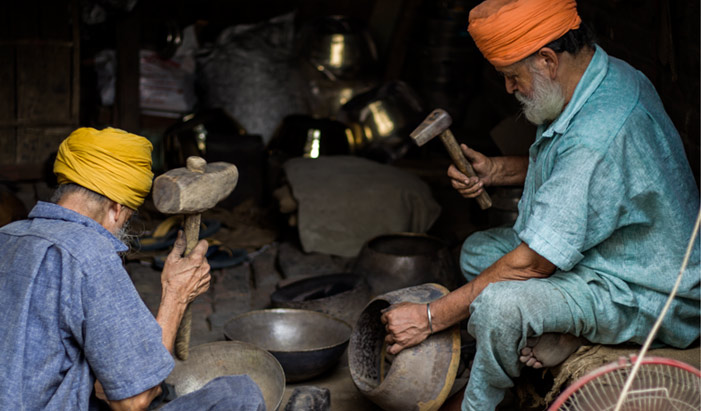
2. Parandi:
Parandi is a long bunch of threads with elaborate decorative tassels at the lower end, and are used by Punjabi women to braid their long hair. Women all over India, wear a lot of jewellery – bangles, tikka, jhumkas, necklace and nath (nose ring). But what makes an outfit typically Punjabi is the Parandi; the fancier the better, the longer the better, and often the braid is wrapped with golden gota (ribbon) to make it even more prominent. Parandi is one of the most fascinating expressions of the Punjabi folk art. Making parandi took roots long ago in Punjab with Patiala being one of the oldest centres of parandi making in the country. Women have always been fond of decorating their hair, but since they were supposed to cover their head, their hair accessories such as golden clips and pins were hardly visible under the dupatta. The maharanis and the women of the royal families of Patiala came up with the clever idea of adorning the lower end of their plaits with rich gold and multi-coloured threads, ribbons and pearls, enhancing the royal look of their attire, with this ingenious hair accessory. Gradually this took the form of Parandis, which are an extension of the plait, and became popular among the masses.
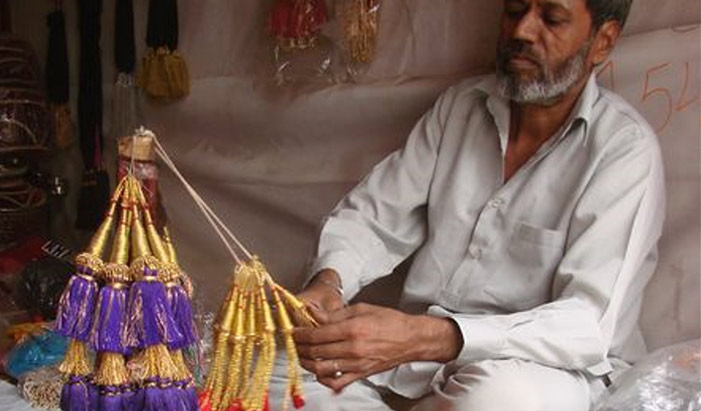
3. Phulkari Embroidery:
Phulkari, meaning "flower work" in Hindi and Punjabi, is a traditional counted-thread embroidery practiced by women in the Punjab region of India and Pakistan. This craft is recognized for its vibrant geometric and natural motifs and holds significant cultural importance, particularly during major life events like marriage. Women often start their embroidery journey with small items, such as odhinis or scarves, and progress to larger pieces like chaddars or shawls, which are frequently passed down through generations. Phulkari shawls, adorned with bright silk threads, are commonly gifted to brides on their wedding day, especially by maternal relatives. The technique involves a running stitch on a coarse handwoven fabric called khaddar, traditionally dyed red using natural plant-based dyes from sources like palash flowers, madder root, or acacia bark. As these colorful threads weave together stories of love and tradition, they create a tapestry that connects generations, celebrating the rich heritage of Punjab.
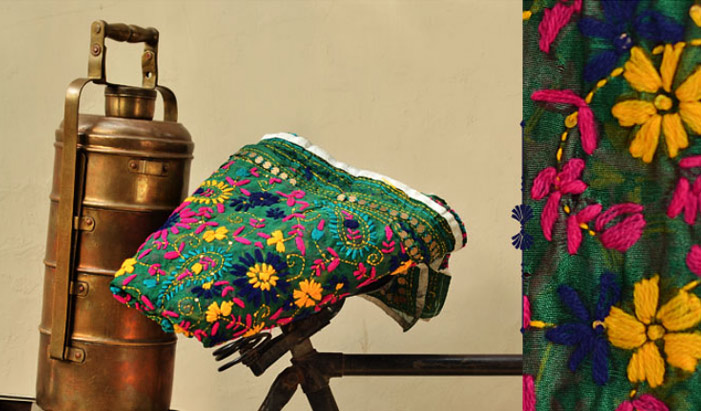
4. Khes:
For generations, women in the villages of Punjab, have woven khes as part of the trousseau they bring to their future homes. Known for their bold, harmonious, and imaginative color patterns, khes serves as both a bed covering and a coverlet for sleeping. Traditionally made of cotton, thinner khes are used as bed coverings in winter, while thicker ones function as shawls. This household craft is primarily created by women for their daughters as part of the dowry. Historians suggest that weaving originated from mat-making, which featured simple geometric patterns, some braided and others coiled. Evidence of similar coiled mats has been found on pottery from Neolithic Indus sites, highlighting the enduring cultural patterns in Punjab. The khes evolved during the Mughal period to fulfill the demand for cotton blankets.
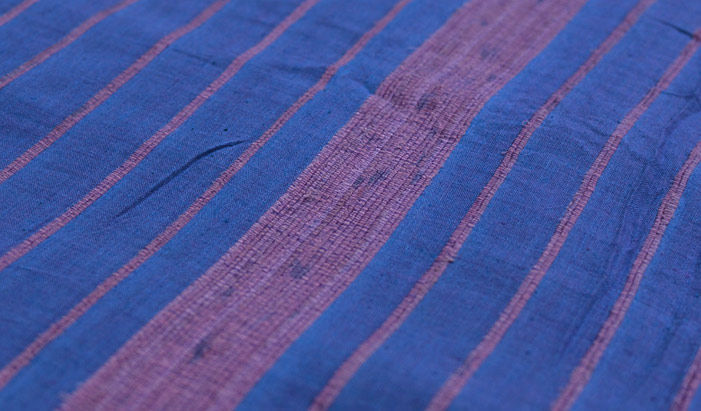
5. Wood Work:
In the heart of Punjab, a timeless tradition of woodwork thrives, highlighting the region's exceptional craftsmanship in crafting beautifully designed furniture, door frames, window panels, and decorative home items. This art form is marked by intricate carvings and patterns that reflect the rich local culture and traditions. Skilled artisans choose premium woods like teak and rosewood, transforming them into stunning pieces adorned with motifs of peacocks, blooming flowers, and complex geometric designs. As the artisans carve each item, they infuse life into the wood, weaving tales of heritage and artistry into every groove and curve. Punjabi wooden crafts are renowned not only for their aesthetic appeal but also for their durability, making them highly desirable for home furnishings and decor. These remarkable creations serve as treasured artifacts, showcasing the artistic brilliance of Punjab and the commitment of those who have perfected their craft over generations. Each piece narrates a story, bridging the past with the present, and inviting admiration from everyone who encounters it.
6. Panja Durries:
After the Partition of India, weavers from Sailkot settled in Nakodar, adapting the craft for sale and export. Presently, durrie patterns can be geometrical or figurative, with major production centers in Moga, Batal, Ludhiana, and more. Durries, flat and pile-less floor coverings made from cotton warp, jute, coir, wool, and sometimes unrefined silk weft, are common in Indian homes and used on traditional bamboo charpoys. Various regional styles exist, with the Panja durries known for bold colors and patterns, woven using a panja on horizontal looms. These durries have a tradition linked to household crafts, woven for personal use, gifts, or wedding trousseaus, with motifs drawn from local flora and fauna. Though women still weave, production is often organized by men in workshops. The craft's origins are debated, with some attributing it to indigenous roots dating back to the early centuries A.D. while others suggest Persian influences, particularly from Turkish and Mughal introductions.
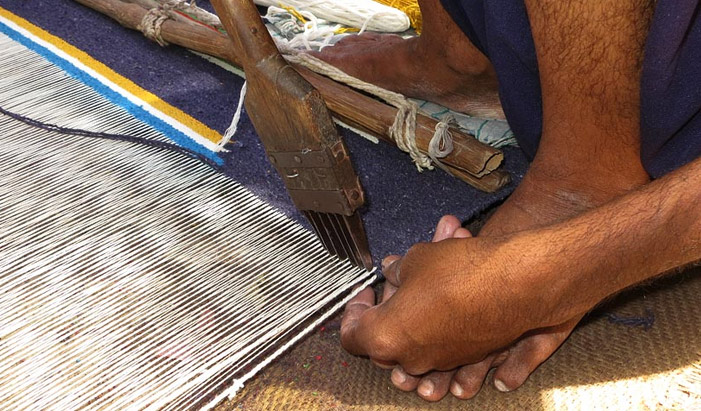
7. Madhubani Painting of Punjab:
Madhubani paintings, originally from the Mithila region of Bihar, have found a vibrant expression in Punjab, where local artists have infused their unique cultural elements into this traditional art form. While Madhubani paintings are celebrated for their intricate patterns and vivid colors, Punjab's variant is particularly noted for its bright hues and detailed designs that reflect Punjabi culture. The specialty of Punjab's Madhubani-style paintings lies in their depiction of local folklore, traditions, and religious themes, often showcasing motifs inspired by nature, animals, flowers, and deities. Created using natural dyes and pigments, these artworks feature elaborate borders and geometric patterns, typically rendered on cloth, paper, or canvas. They not only serve as a medium for storytelling and celebrating festivals but also hold cultural significance in various Punjabi rituals, enriching the artistic tapestry of the region while preserving the rich heritage of Madhubani art.
9. Folk Toys of Punjab:
The folk toys of Punjab are a vibrant reflection of the region's rich cultural heritage and artistic traditions. Crafted primarily from natural materials like clay, wood, and cloth, these toys often depict local folklore, animals, and traditional characters. Popular items include kukkad (rooster) figurines, intricately painted wooden tops, and colorful gaddis (puppets) used in folk performances. Each toy carries a story, serving not only as entertainment but also as a means of preserving Punjabi culture and values. The craftsmanship involved in creating these toys showcases the skills passed down through generations, making them cherished artifacts that continue to delight children and adults alike. As modern technology encroaches on traditional play, these folk toys stand as a testament to the enduring spirit of Punjab's artistic legacy.
10. Punjabi Pottery:
Punjabi pottery is a time-honoured craft that has been lovingly passed down through generations. Renowned for its simplicity and rustic appeal, this traditional art form showcases the skill of artisans who shape clay into a variety of functional items, including pots, vases, and pitchers. Often adorned with geometric patterns and earthy hues, these pieces embody the region's cultural essence. Fired at high temperatures for enhanced durability, many items are also painted or glazed, adding a splash of vibrancy. Reflecting the agrarian lifestyle of Punjab, these handcrafted creations serve practical purposes, such as water pitchers and cooking pots. Their blend of functionality and aesthetic charm makes Punjabi pottery not just useful, but also culturally significant treasures.
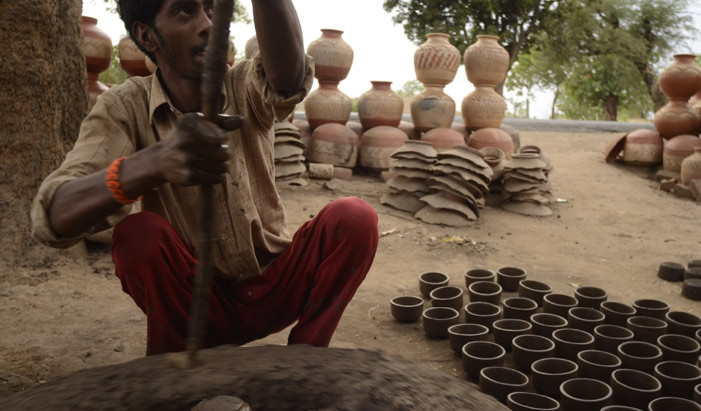

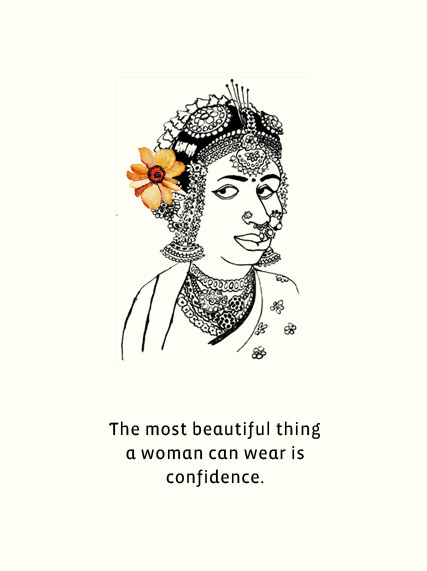

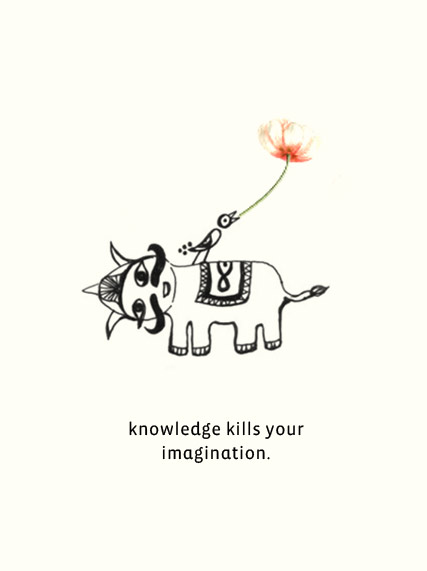

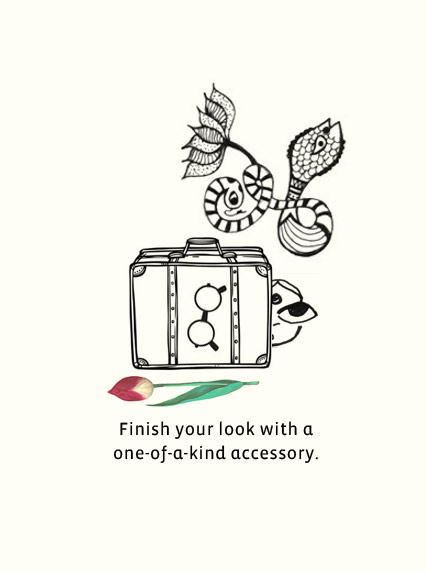


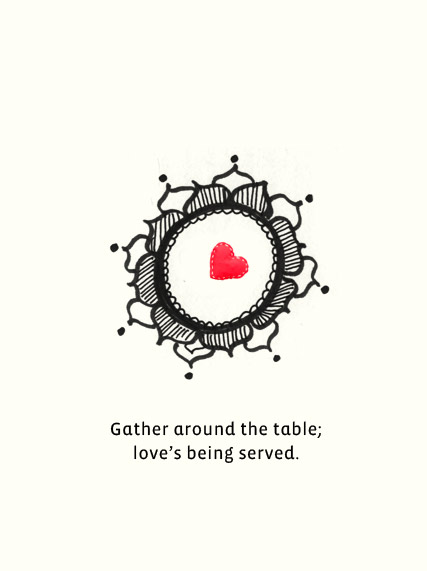
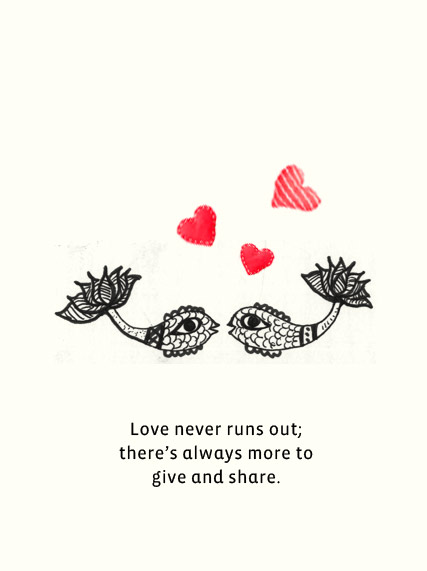
Leave a Comment